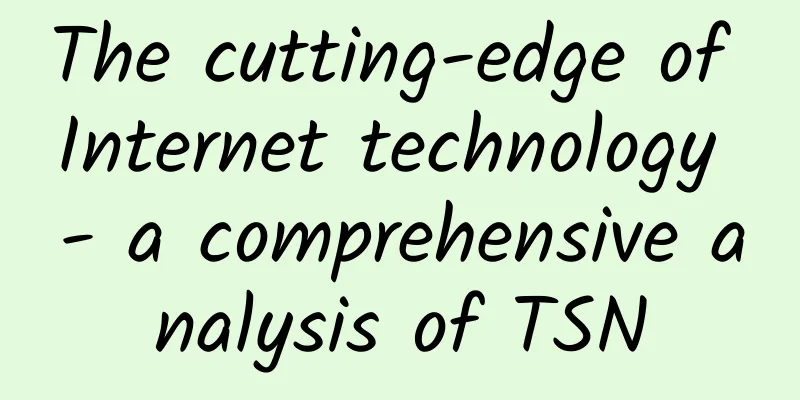The cutting-edge of Internet technology - a comprehensive analysis of TSN

|
TSN is the abbreviation of time-sensitive networking. TSN is a series of standards based on traditional Ethernet networks that have forward compatibility, good real-time data transmission, certainty of minimum transmission time, universality of communication on transmission standards, and reliability of information transmission. TSN is the data collection and transmission standard of the MAC layer. Together with the specification utility of the language parsing of the OPC UA protocol architecture, it constitutes the technical support for industrial real-time interconnection. TSN was initially developed by the IEEE802.1 working group, and was renamed from the existing audio and video bridge working group in 2012. It is committed to solving the information transmission delay problem caused by data overlap and the reliable and universal interoperability of IoT devices. TSN has advantages in bandwidth, security and interoperability, and can well meet the requirements of the future Internet of Everything. Its main working principle is the priority application (IEEE P802.3br) mechanism, which gives priority to key data packets during transmission. This means that critical data does not have to wait until all non-critical data has been transmitted before it can begin, thus ensuring a faster transmission path. 802.1CB replicates and eliminates frames for reliability, forcing reliable communication regardless of link failures, cable breaks, and other errors. This option ensures that copies of critical traffic can be transmitted in disjoint paths in the network, retaining only any packets that arrive at the destination first, thereby achieving seamless redundancy. In addition, TSN reserves time slots for the transmission of important real-time data, while traditional Ethernet has frequent transmission data overlaps, and traditional data buffering and queue priorities are not obvious, leading to difficulties in the use of Ethernet in industry. TSN has excellently solved these common problems in industrial scenarios and has made outstanding contributions to the breadth and depth of industrial Ethernet applications. The most important thing about TSN is the handling of time issues. In this regard, the IEEE802.1 working group focused on solving the problem of clock synchronization, ensuring that the clocks of various device nodes connected in the network are synchronized and achieve microsecond-level accuracy errors. An optimized time-aware scheduler is set up to divide data traffic into different types, allocate specific time slots for time-sensitive critical data with higher priority, and at specified time nodes, all nodes in the network must prioritize the passage of important data frames. Next comes work on scheduling and traffic shaping. Scheduling and traffic shaping allow different traffic classes of different priorities to coexist on the same network, each with different requirements for available bandwidth and end-to-end latency. In industrial automation and automotive automotive environments, where Ethernet is used for closed-loop control or safety applications, reliable and timely delivery is critical. For the Ethernet used here, the strict priority scheduling of IEEE 802.1Q needs to be enhanced. TSN's utility in this regard enhances the real-time and deterministic nature of data transmission. Third, the TSN working group has adopted a multi-path setting in the setting of communication paths, which ensures the stability of data transmission and high fault tolerance. There are also reserved paths for data transmission, which solves the problem of data transmission congestion and ensures the real-time performance of data transmission. TSN also adds network management and configuration protocols to achieve dynamic configuration of network parameters to meet various changes in device nodes and data requirements. Compared with traditional Ethernet, TSN has taken a step further in the integration of IT and OT. In the context of IT and OT integration, it is necessary not only to ensure the transmission of large data, but also to ensure the real-time and deterministic transmission. The existing real-time Ethernet protocol is even more incapable. TSN further optimizes the process of data collection, transmission and information integration, and improves the process rate. Secondly, TSN's handling of time issues ensures the reliability and time accuracy of the industrial production process. It has greatly improved the Ethernet application rate and production standardization in industrial scenarios. Ethernet uses the Carrier Sense Multiple Access/Collision Detection (CSMA/CD) mechanism. When two workstations collide, they must resend the message after a certain delay. When congestion occurs, some messages may take a long time to be released, causing uncertainty in communication time. Therefore, traditional Ethernet is generally not used for industrial automation control, but it can be used in places where real-time requirements are not high. Secondly, TSN's guarantee of real-time performance better meets the requirements for higher time accuracy, such as autonomous driving. Of course, TSN is only a protocol standard for the MAC layer, which is not enough for the standard construction of the entire Ethernet. It solves the problem of data transmission, and better semantic analysis depends on the protocol optimization of OPC UA. |
Recommend
Overview of 5G Industry Terminal Development
With the continuous development of the fifth gene...
Hostodo October Promotion: $45/year KVM-3GB/30G NVMe/5TB/three computer rooms
Hostodo has launched the Spooky October Sale, off...
Swan Award soars again: The 7th China Mobile Phone Design Competition kicks off on Telecom Day
On the occasion of the 51st World Telecommunicati...
Why do enterprises need a dedicated core network?
Just a few years ago, a global mobile private net...
TmhHost Double 11: Japan/Hong Kong/US CN2 GIA high defense 20% off quarterly payment from 79.2 yuan, Hong Kong CN2/Japan CN2 monthly payment from 28 yuan
TmhHost launched a series of promotional plans du...
The impact of 5G technology on these 20 industries
5G, a new era product developed in response to th...
China Mobile has built more than 410,000 5G base stations
On April 25, China Mobile General Manager Dong Xi...
[11.11] HostingViet: Vietnam VPS annual payment 40% off, 2GB/20G SSD/unlimited traffic/annual payment starting from 193 yuan
HostingViet also launched a Double 11 event. From...
RAKsmart: Los Angeles/San Jose E3 servers at $30.62/month, Japan/Korea E5 servers starting at $59/month
This month, RAKsmart launched a flash sale for in...
DiyVM: Japan Osaka/US Los Angeles/Hong Kong Shatin CN2 line 2G memory VPS monthly payment starts from 50 yuan
DiyVM has recently made major changes to the webs...
How to fill every corner of the room with Wi-Fi?
Nowadays, in a large living environment, there ar...
Take off, I made an LRU cache by hand, the source code turned out to be so simple!
LRU Introduction LRU is the abbreviation of Least...
In which industries can blockchain be applied?
In recent years, blockchain technology has become...
TCP Sliding Window Principle Analysis
I. Summary A few days ago, when I was sharing an ...
What are the most exciting IoT trends for 2018?
The Internet of Things is accelerating its entry ...









